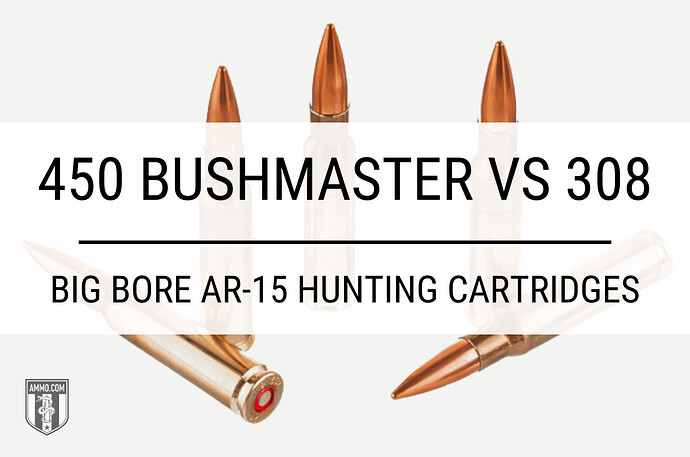The 450 Bushmaster allows a deer hunter to convert their AR-15 carbine into a whitetail slaying machine simply by changing its bolt, barrel, and magazine follower.
But is it worth converting your AR-15 to the relatively new 450 Bushmaster – or would you be better served by sticking with the all-American hunting cartridge, the 308 Winchester?
In this article we analyze the differences between the 450 BM and the 308 Win so that you can make a more informed decision on your next hunting rifle cartridge.
What Is the Difference Between 450 Bushmaster and 308?
The 450 Bushmaster fires a 0.452” diameter bullet: almost 50% wider than the 308 Winchester’s 0.308” diameter bullet. Furthermore, the 308 has a bottleneck case, whereas the 450’s case is straight-walled.
Cartridge Specs
When evaluating centerfire cartridges, it’s good to begin by comparing their physical specifications. The 308’s bottleneck case doesn’t just look different from the 450’s straight-walled one. It also improves ballistic performance (as it prevents the tail of the bullet from occupying space that powder otherwise could have). The 450’s straight-walled case is an intentional compromise. Regulations in Michigan, Indiana, Illinois, Iowa, and Ohio all require the use of straight-walled cartridges for deer hunting.
Another major difference between 450 and 308 is bullet diameter. The 308 Win fires the tried-and-true 0.308” diameter bullet, whereas the 450 Bushmaster fires a wider (and less ballistically efficient) 0.452” bullet.
The 450 Bushmaster generally fires bullets weighing between 158 and 300 grains, with 250 and 260 grain loadings being most popular. In contrast, the 308 generally fires bullets weighing between 110 and 180 grains, with 150, 165 and 180 grain loads having the most fans.
The 308’s case length and overall length (OAL) are considerably longer than those of the 450. The 450 is stubby by design, as it was conceived to fit a standard AR-15 magazine (which allows a maximum overall length of 2.26”). Design of the 308 (2.8” OAL) predated formal designation of the STANAG magazine by almost 30 years.
Both rifle cartridges’ case capacities are nearly identical, though the 450 has slightly more (59.5gr H2O) than the 308 (56.0gr H2O).
The final major difference between the two rifle cartridges are their maximum pressures. SAAMI specifies that the 308 can handle 62,000 psi – whopping compared to 38,500 psi for the 450.
Straight-walled cartridges generally have lower chamber pressures. The 450 is no exception, though its pressure is still high relative to the AR-15 recoil system’s capabilities. The powerful 450 generates quite a fair bit of recoil, and exerts considerable bolt thrust against the recoil buffer and spring as a result. The 450’s pressure is just about the highest the AR-15 platform can accommodate before risking becoming damaged.
Recoil
The 308 and 450 are no slouches when it comes to recoil.
Free recoil energy is determined by four factors: firearm weight, powder charge weight, bullet weight, and muzzle velocity.
On average, 450 recoil measures approximately 24 ft-lbs; about one-fifth higher than the 308’s average of 20 ft-lbs. To put this into context, the 450 has just 3 ft-lbs less recoil energy than a 2-¾” 12 Gauge shotgun shell firing a 1 ounce slug.
That’s quite a lot of kick for an AR-15, though it can be mitigated with the use of a muzzle brake (or by making the firearm heavier).
The difference in recoil between the 450 and 308 isn’t too drastic, although the 308’s gentler kick does make it the better option for recoil-sensitive shooters.
Muzzle Velocity and Kinetic Energy
The 308 reigns supreme when it comes to muzzle velocity and kinetic energy. This is largely due to its more efficient bottleneck design and higher pressure.
For this comparison, we will compare Hornady Superformance 308 165gr SST and Hornady Custom 450 250gr FTX ammunition.
The 308 bullet screams out of the barrel at a velocity of 2,840 fps, with 2,955 ft-lbs accompanying muzzle energy. Both facets of the 308’s muzzle performance outshine the 450 load’s 2,200 fps and 2,686 ft-lbs.
The 308 still outpaces the 450 when it is loaded with a heavier 178gr ELD-X bullet: 2,600 fps and 2,672 ft-lbs.
In terms of muzzle velocity and muzzle energy, the 308 clearly dominates.
Trajectory
Trajectory is how we quantify a bullet’s flight path as it travels downrange, measured in inches of bullet drop.
A flatter-shooting cartridge is preferable for long-range shooting, as it allows a shooter to make fewer adjustments compensating for gravity. A flatter trajectory also means a cartridge will be more forgiving of ranging mistakes.
There’s a reason why the 308 has been used for long-range shooting for over seven decades, and why you’ll never see the 450 at any F-Class competition firing lines. The 308 exhibits a considerably flatter trajectory compared to the 450 Bushmaster – especially at longer ranges.
To illustrate this, we will compare the same Hornady 308 165gr SST and 450 250gr FTX loads as we did in the previous section.
At 250 yards (which many consider the maximum effective range of the 450), the 250gr FTX exhibits -19” of bullet drop, plummeting compared to the 165gr SST’s -7” drop at the same distance, when zeroed at 100 yards.
This difference only becomes more dramatic at long range. At 400 yards, the 450 Bushmaster round has transitioned to subsonic and exhibited -80” drop, while the 308 has maintained supersonic velocity and only exhibited -29” drop.
The 308, which is designed for long-range shooting, dominates in terms of trajectory.
Continue reading 450 Bushmaster vs. 308: Big Bore AR-15 Hunting Cartridges on Ammo.com

